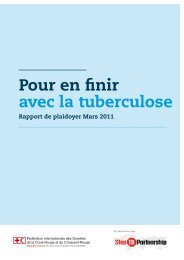molecular line probe assays for rapid screening of patients at risk of ...
molecular line probe assays for rapid screening of patients at risk of ...
molecular line probe assays for rapid screening of patients at risk of ...
You also want an ePaper? Increase the reach of your titles
YUMPU automatically turns print PDFs into web optimized ePapers that Google loves.
MOLECULAR LINE PROBE ASSAYS FOR RAPID SCREENING OF<br />
PATIENTS AT RISK OF MULTIDRUG-RESISTANT TUBERCULOSIS<br />
(MDR-TB)<br />
POLICY STATEMENT<br />
27 June 2008
POLICY STATEMENT<br />
MOLECULAR LINE PROBE ASSAYS FOR RAPID SCREENING OF<br />
PATIENTS AT RISK OF MULTIDRUG-RESISTANT TUBERCULOSIS<br />
(MDR-TB)<br />
1. Background<br />
Multidrug-resistant tuberculosis (MDR-TB) poses a <strong>for</strong>midable challenge to TB control due to<br />
its complex diagnostic and tre<strong>at</strong>ment challenges. The annual global MDR-TB burden is<br />
estim<strong>at</strong>ed <strong>at</strong> around 490 000 cases, or 5% <strong>of</strong> the global TB burden; however, less than 5% <strong>of</strong><br />
existing MDR-TB <strong>p<strong>at</strong>ients</strong> are currently being diagnosed as a result <strong>of</strong> serious labor<strong>at</strong>ory<br />
capacity constraints. Alarming increases in MDR-TB, the emergence <strong>of</strong> extensively drugresistant<br />
TB (XDR-TB), potential institutional transmission, and <strong>rapid</strong> mortality <strong>of</strong> MDR-TB and<br />
XDR-TB p<strong>at</strong>ient with HIV co-infection, have highlighted the urgency <strong>for</strong> <strong>rapid</strong> <strong>screening</strong><br />
methods.<br />
Conventional methods <strong>for</strong> mycobacteriological culture and drug susceptibility testing (DST) are<br />
slow and cumbersome, requiring sequential procedures <strong>for</strong> isol<strong>at</strong>ion <strong>of</strong> mycobacteria from<br />
clinical specimens, identific<strong>at</strong>ion <strong>of</strong> Mycobacterium tuberculosis complex, and in vitro testing <strong>of</strong><br />
strain susceptibility to anti-TB drugs. During this time <strong>p<strong>at</strong>ients</strong> may be inappropri<strong>at</strong>ely tre<strong>at</strong>ed,<br />
drug resistant strains may continue to spread, and amplific<strong>at</strong>ion <strong>of</strong> resistance may occur.<br />
Novel technologies <strong>for</strong> <strong>rapid</strong> detection <strong>of</strong> anti-TB drug resistance have there<strong>for</strong>e become a<br />
priority in TB research and development, and <strong>molecular</strong> <strong>line</strong> <strong>probe</strong> <strong>assays</strong> focused on <strong>rapid</strong><br />
detection <strong>of</strong> rifampicin resistance (alone or in combin<strong>at</strong>ion with isoniazid) are most advanced.<br />
Line <strong>probe</strong> assay technology involves the following steps: First, DNA is extracted from M.<br />
tuberculosis isol<strong>at</strong>es or directly from clinical specimens. Next, polymerase chain reaction (PCR)<br />
amplific<strong>at</strong>ion <strong>of</strong> the resistance-determining region <strong>of</strong> the gene under question is per<strong>for</strong>med<br />
using biotinyl<strong>at</strong>ed primers. Following amplific<strong>at</strong>ion, labeled PCR products are hybridized with<br />
specific oligonucleotide <strong>probe</strong>s immobilized on a strip. Captured labeled hybrids are detected<br />
by colorimetric development, enabling detection <strong>of</strong> the presence <strong>of</strong> M. tuberculosis complex,<br />
as well as the presence <strong>of</strong> wild-type and mut<strong>at</strong>ion <strong>probe</strong>s <strong>for</strong> resistance. If a mut<strong>at</strong>ion is<br />
present in one <strong>of</strong> the target regions, the amplicon will not hybridize with the relevant <strong>probe</strong>.<br />
Mut<strong>at</strong>ions are there<strong>for</strong>e detected by lack <strong>of</strong> binding to wild-type <strong>probe</strong>s, as well as by binding<br />
to specific <strong>probe</strong>s <strong>for</strong> the most commonly occurring mut<strong>at</strong>ions. The post-hybridiz<strong>at</strong>ion<br />
reaction leads to the development <strong>of</strong> coloured bands on the strip <strong>at</strong> the site <strong>of</strong> <strong>probe</strong> binding<br />
and is observed by eye.<br />
2. Evidence base<br />
2.1 Process<br />
An Expert Group was convened by the World Health Organiz<strong>at</strong>ion (WHO) and the<br />
UNICEF/UNDP/World Bank/WHO Special Programme <strong>for</strong> Research and Training in Tropical<br />
Diseases (TDR) in March 2008, to assess available d<strong>at</strong>a on <strong>line</strong> <strong>probe</strong> <strong>assays</strong> with a view<br />
towards policy recommend<strong>at</strong>ions on their use. D<strong>at</strong>a from published liter<strong>at</strong>ure, labor<strong>at</strong>ory<br />
valid<strong>at</strong>ion studies, and investig<strong>at</strong>or-driven labor<strong>at</strong>ory and field demonstr<strong>at</strong>ion studies were<br />
used to assess assay per<strong>for</strong>mance and feasibility <strong>of</strong> programm<strong>at</strong>ic implement<strong>at</strong>ion. The<br />
associ<strong>at</strong>ed labor<strong>at</strong>ory infrastructure, human resource requirements and research gaps were<br />
also defined.<br />
An extensive liter<strong>at</strong>ure search resulted in published in<strong>for</strong>m<strong>at</strong>ion on proven efficacy from two<br />
commercial <strong>line</strong> <strong>probe</strong> <strong>assays</strong>. To the best <strong>of</strong> knowledge, these are currently the only<br />
2
products available. Although the specific commercial <strong>assays</strong> are under p<strong>at</strong>ent, the underlying<br />
<strong>line</strong> <strong>probe</strong> assay technology is in the public domain.<br />
Tests used to in<strong>for</strong>m p<strong>at</strong>ient care can only be ethically justifiable if per<strong>for</strong>med with a product<br />
th<strong>at</strong> has met pre-defined per<strong>for</strong>mance targets in carefully controlled evalu<strong>at</strong>ion studies, and<br />
which have been registered <strong>for</strong> a given indic<strong>at</strong>ion. Both commercial <strong>assays</strong> evalu<strong>at</strong>ed are<br />
manufactured under ISO 13485:2003 certific<strong>at</strong>ion, <strong>of</strong>fering the advantage <strong>of</strong> quality-assured<br />
reagents and test kits, and labeled <strong>for</strong> use under defined conditions. The tests are also<br />
approved by the Regul<strong>at</strong>ory Authority in Europe (CE-Marked) and elsewhere.<br />
In-house <strong>line</strong> <strong>probe</strong> <strong>assays</strong>, developed in academic research settings, have not been<br />
adequ<strong>at</strong>ely valid<strong>at</strong>ed or evalu<strong>at</strong>ed outside <strong>of</strong> such settings, and their use <strong>for</strong> clinical care <strong>of</strong><br />
<strong>p<strong>at</strong>ients</strong> is there<strong>for</strong>e not recommended.<br />
While it is likely th<strong>at</strong> additional <strong>assays</strong> may become available in the future, these will need to<br />
be subjected to the same level <strong>of</strong> valid<strong>at</strong>ion and expert review be<strong>for</strong>e their implement<strong>at</strong>ion can<br />
be recommended by WHO.<br />
2.2 Results<br />
D<strong>at</strong>a from system<strong>at</strong>ic reviews and meta-analyses to evalu<strong>at</strong>e assay per<strong>for</strong>mance results<br />
against conventional DST methods showed th<strong>at</strong> <strong>line</strong> <strong>probe</strong> <strong>assays</strong> are highly sensitive (>=97%)<br />
and specific (>=99%) <strong>for</strong> the detection <strong>of</strong> rifampicin resistance, alone or in combin<strong>at</strong>ion with<br />
isoniazid (sensitivity >=90%; specificity >=99%), on isol<strong>at</strong>es <strong>of</strong> M. tuberculosis and on<br />
smear-positive sputum specimens. Overall accuracy <strong>for</strong> detection <strong>of</strong> MDR was equally high <strong>at</strong><br />
99%, and retained when rifampicin resistance alone was used as a marker <strong>for</strong> MDR. These<br />
results were confirmed by labor<strong>at</strong>ory valid<strong>at</strong>ion and field demonstr<strong>at</strong>ion d<strong>at</strong>a in several<br />
countries, most notably in the large-scale demonstr<strong>at</strong>ion project in South Africa, executed by<br />
the Found<strong>at</strong>ion <strong>for</strong> Innov<strong>at</strong>ive New Diagnostics (FIND), the SA Medical Research Council<br />
(SAMRC) and the SA N<strong>at</strong>ional Health Labor<strong>at</strong>ory Service (NHLS).<br />
D<strong>at</strong>a from the valid<strong>at</strong>ion and field demonstr<strong>at</strong>ion studies in South Africa also indic<strong>at</strong>ed the<br />
feasibility <strong>of</strong> introducing <strong>line</strong> <strong>probe</strong> <strong>assays</strong> in high-volume public health labor<strong>at</strong>ories. Detailed<br />
costing d<strong>at</strong>a from South Africa showed th<strong>at</strong> the reduction in cost <strong>of</strong> <strong>line</strong> <strong>probe</strong> <strong>assays</strong> under<br />
routine diagnostic algorithms amounted to between 30% and 50% when compared to<br />
conventional DST methods. As expected, the cost was lowest when the <strong>line</strong> <strong>probe</strong> assay was<br />
directly applied to smear-positive specimens and highest when the assay was used on isol<strong>at</strong>es<br />
from liquid primary culture.<br />
Cost-effectiveness and cost-benefit <strong>of</strong> <strong>line</strong> <strong>probe</strong> <strong>assays</strong> remain to be assessed, and will be<br />
dependent on <strong>screening</strong> and diagnostic algorithms in different epidemiological settings.<br />
Detailed cost-effectiveness and p<strong>at</strong>ient impact d<strong>at</strong>a will only be available once large-scale field<br />
demonstr<strong>at</strong>ion projects have been completed.<br />
Apart from the impact on morbidity, mortality and transmission <strong>of</strong> MDR-TB, introduction <strong>of</strong><br />
these <strong>assays</strong> in <strong>screening</strong> and diagnostic algorithms could significantly reduce the need <strong>for</strong><br />
sophistic<strong>at</strong>ed and costly conventional labor<strong>at</strong>ory infrastructure, still vastly inadequ<strong>at</strong>e in most<br />
high-burden countries. The Expert Group concluded th<strong>at</strong> there was sufficient generalisable<br />
evidence to justify a recommend<strong>at</strong>ion on the use <strong>of</strong> <strong>line</strong> <strong>probe</strong> <strong>assays</strong> <strong>for</strong> <strong>rapid</strong> detection <strong>of</strong><br />
MDR-TB, <strong>at</strong> country level, and with further oper<strong>at</strong>ional research to address country-specific<br />
implement<strong>at</strong>ion needs.<br />
Line <strong>probe</strong> <strong>assays</strong> are not a complete replacement <strong>for</strong> conventional culture and DST, as<br />
mycobacteriological culture is still required <strong>for</strong> smear-neg<strong>at</strong>ive specimens while conventional<br />
DST is still necessary to confirm XDR-TB. Nevertheless; the implement<strong>at</strong>ion if <strong>line</strong> <strong>probe</strong><br />
<strong>assays</strong> in MDR-TB <strong>screening</strong> algorithms may significantly reduce the demand on conventional<br />
culture and DST labor<strong>at</strong>ory capacity.<br />
3
3. Implement<strong>at</strong>ion consider<strong>at</strong>ions<br />
As with any new technology, a range <strong>of</strong> implement<strong>at</strong>ion issues was identified, without which<br />
<strong>line</strong> <strong>probe</strong> <strong>assays</strong> would not be useful. These include:<br />
3.1 Specimen collection, storage and transport<br />
The quality <strong>of</strong> sputum specimens submitted to the labor<strong>at</strong>ory is critical in obtaining reliable<br />
results with <strong>line</strong> <strong>probe</strong> <strong>assays</strong>, as with other tests. Although contamin<strong>at</strong>ion <strong>of</strong> specimens due<br />
to inappropri<strong>at</strong>e storage and long transport times <strong>of</strong> specimens to the labor<strong>at</strong>ory is less <strong>of</strong> a<br />
concern than with conventional culture-based approaches, a reliable specimen transport<br />
system will ensure th<strong>at</strong> the full benefit is gained from use <strong>of</strong> a <strong>rapid</strong> assay, by reducing<br />
diagnostic delay times.<br />
Current WHO recommend<strong>at</strong>ions call <strong>for</strong> MDR strains to be screened <strong>for</strong> XDR, both during<br />
surveys and in clinical settings where XDR-TB <strong>p<strong>at</strong>ients</strong> are suspected or confirmed.<br />
Refriger<strong>at</strong>ed transport <strong>of</strong> specimens and <strong>rapid</strong> delivery systems are essential <strong>for</strong> conventional<br />
culture and DST procedures; there<strong>for</strong>e, strict adherence to standard oper<strong>at</strong>ing procedures <strong>for</strong><br />
specimen collection, storage and transport will be necessary if labor<strong>at</strong>ories wish to implement<br />
second-<strong>line</strong> culture-based DST on specimens found to be MDR-TB by <strong>line</strong> <strong>probe</strong> assay.<br />
3.2 Biosafety<br />
Line <strong>probe</strong> <strong>assays</strong> require the digestion, decontamin<strong>at</strong>ion and concentr<strong>at</strong>ion <strong>of</strong> clinical<br />
specimens prior to DNA extraction. These processes involve aerosol-producing methods such<br />
as homogeniz<strong>at</strong>ion and centrifug<strong>at</strong>ion which pose a considerable <strong>risk</strong> <strong>of</strong> infection as well as<br />
cross-contamin<strong>at</strong>ion <strong>of</strong> specimens. The processing <strong>of</strong> specimens <strong>for</strong> <strong>line</strong> <strong>probe</strong> <strong>assays</strong> should<br />
there<strong>for</strong>e be per<strong>for</strong>med in a labor<strong>at</strong>ory with adequ<strong>at</strong>e and appropri<strong>at</strong>e biosafety level<br />
precautions.<br />
Current WHO recommend<strong>at</strong>ions specify th<strong>at</strong> specimen processing <strong>for</strong> mycobacterial culture be<br />
per<strong>for</strong>med in a biological safety cabinet (BSC) under <strong>at</strong> least biosafety level 2 (BSL2)<br />
conditions. Procedures involving manipul<strong>at</strong>ion <strong>of</strong> M. tuberculosis cultures (identific<strong>at</strong>ion, subculturing<br />
and DST) must be per<strong>for</strong>med in labor<strong>at</strong>ories complying with BSL3 standards.<br />
Applying these recommend<strong>at</strong>ions to <strong>line</strong> <strong>probe</strong> <strong>assays</strong>, processing <strong>of</strong> smear-positive specimens<br />
<strong>for</strong> direct testing should be per<strong>for</strong>med in a BSL2 level labor<strong>at</strong>ory, whereas per<strong>for</strong>ming the<br />
assay on positive cultures would require BSL3 facilities.<br />
Conceivably, sputum specimens could be rendered non-infectious be<strong>for</strong>e shipping to the<br />
referral labor<strong>at</strong>ory, obvi<strong>at</strong>ing the need <strong>for</strong> BSL2 facilities; however, while <strong>line</strong> <strong>probe</strong> <strong>assays</strong> are<br />
likely to per<strong>for</strong>m well on specimens inactiv<strong>at</strong>ed/disinfected after collection, there are currently<br />
no sufficient d<strong>at</strong>a to recommend this practice. It should also be kept in mind th<strong>at</strong><br />
inactiv<strong>at</strong>ion/disinfection <strong>of</strong> specimens result in loss <strong>of</strong> viability <strong>of</strong> organisms and th<strong>at</strong><br />
subsequent culture (eg. <strong>for</strong> smear-neg<strong>at</strong>ive specimens) and DST (eg. <strong>for</strong> second-<strong>line</strong> anti-TB<br />
drugs to detect XDR) will not be possible.<br />
Once the decontamin<strong>at</strong>ed specimens have been den<strong>at</strong>ured (by he<strong>at</strong>ing), organisms present in<br />
the specimen are rendered non-viable. Subsequent steps may there<strong>for</strong>e be per<strong>for</strong>med outside<br />
<strong>of</strong> the BSC; however, due consider<strong>at</strong>ion needs to be given to preventing amplicon<br />
contamin<strong>at</strong>ion through stringent cleaning and working practices.<br />
3.3 Labor<strong>at</strong>ory design<br />
Precautions to reduce the <strong>risk</strong> <strong>of</strong> cross-contamin<strong>at</strong>ion <strong>of</strong> DNA <strong>molecular</strong> procedures are critical.<br />
This is achieved by using different rooms <strong>for</strong> DNA extraction, prepar<strong>at</strong>ion <strong>of</strong> reagents <strong>for</strong> PCR<br />
(pre-amplific<strong>at</strong>ion), PCR amplific<strong>at</strong>ion and hybridiz<strong>at</strong>ion, and interpret<strong>at</strong>ion <strong>of</strong> results (postamplific<strong>at</strong>ion).<br />
Restricted access and uni-directional workflow through the rooms further<br />
4
educe the likelihood <strong>of</strong> amplicon contamin<strong>at</strong>ion. Careful cleaning <strong>of</strong> all rooms after each use<br />
is also critical.<br />
Due to space constraints it may not be possible to provide separ<strong>at</strong>e rooms <strong>for</strong> each step <strong>of</strong> the<br />
process in all settings. As a minimum requirement, three separ<strong>at</strong>e rooms <strong>for</strong> the different<br />
<strong>molecular</strong> steps should be established – one <strong>for</strong> DNA extraction, one <strong>for</strong> pre-amplific<strong>at</strong>ion<br />
procedures, and one <strong>for</strong> amplific<strong>at</strong>ion and post-amplific<strong>at</strong>ion processes. As large equipment is<br />
not required <strong>for</strong> running the <strong>assays</strong>, the rooms can be fairly small in size. Restricted access,<br />
<strong>at</strong>tention to the direction <strong>of</strong> workflow, and meticulously followed procedures <strong>for</strong> cleaning, are<br />
critical in <strong>at</strong>taining s<strong>at</strong>isfactory results.<br />
In most settings, renov<strong>at</strong>ions may be required to provide adequ<strong>at</strong>e facilities <strong>for</strong> per<strong>for</strong>ming<br />
<strong>line</strong> <strong>probe</strong> <strong>assays</strong> and the time, space and resources required <strong>for</strong> such renov<strong>at</strong>ions should be<br />
carefully considered.<br />
3.4 Electrical supply and back-up power<br />
Reagents used in <strong>line</strong> <strong>probe</strong> <strong>assays</strong> must be refriger<strong>at</strong>ed or frozen, while amplific<strong>at</strong>ion and<br />
hybridiz<strong>at</strong>ion procedures must be conducted under closely monitored temper<strong>at</strong>ure conditions.<br />
Uninterrupted power supply (UPS) connection is required during PCR amplific<strong>at</strong>ion and use <strong>of</strong><br />
the autom<strong>at</strong>ed hybridiz<strong>at</strong>ion systems to avoid interruption <strong>of</strong> the procedure and subsequent<br />
loss <strong>of</strong> results.<br />
Use <strong>of</strong> <strong>line</strong> <strong>probe</strong> <strong>assays</strong> there<strong>for</strong>e poses challenges in settings where interruption <strong>of</strong> the<br />
electrical power supply is common. Connection <strong>of</strong> labor<strong>at</strong>ory power supply to a back-up<br />
gener<strong>at</strong>or and UPS is strongly recommended in such settings.<br />
3.5 Reagent quality and shelf-life<br />
Molecular grade w<strong>at</strong>er and Taq polymerase are required <strong>for</strong> PCR amplific<strong>at</strong>ion. The quality <strong>of</strong><br />
these reagents may critically affect the per<strong>for</strong>mance <strong>of</strong> <strong>line</strong> <strong>probe</strong> <strong>assays</strong>, and locally available<br />
reagents should be valid<strong>at</strong>ed prior to use.<br />
Short expir<strong>at</strong>ion d<strong>at</strong>es <strong>of</strong> reagents are a concern <strong>for</strong> labor<strong>at</strong>ories, especially in rel<strong>at</strong>ively<br />
inaccessible areas with complex customs clearance procedures. Management <strong>of</strong> inventory<br />
based on usage, shelf-life and lead time <strong>for</strong> deliver <strong>of</strong> orders is there<strong>for</strong>e needed.<br />
3.6 Equipment<br />
In addition to the equipment required <strong>for</strong> initial digestion-decontamin<strong>at</strong>ion <strong>of</strong> sputum<br />
specimens (such as BSCs and safety centrifuges), <strong>line</strong> <strong>probe</strong> <strong>assays</strong> require specific equipment<br />
<strong>for</strong> <strong>molecular</strong> procedures such as a thermal cycler, shaking pl<strong>at</strong><strong>for</strong>m and w<strong>at</strong>er b<strong>at</strong>h, he<strong>at</strong>ing<br />
block, sonic<strong>at</strong>or, micro centrifuge and tubes, hybridiz<strong>at</strong>ion instrument, fridge, freezer,<br />
micropipettes and pipette tips, and PCR tubes. These are available from various commercial<br />
suppliers.<br />
Correct specific<strong>at</strong>ions <strong>of</strong> equipment should be confirmed with <strong>line</strong> <strong>probe</strong> assay manufacturers<br />
and adequ<strong>at</strong>e lead time <strong>for</strong> procurement <strong>of</strong> such items must be allowed when implementing<br />
these <strong>assays</strong>.<br />
Certain equipment such as incub<strong>at</strong>ors and autom<strong>at</strong>ed hybridiz<strong>at</strong>ion systems are productspecific.<br />
Both commercial <strong>line</strong> <strong>probe</strong> <strong>assays</strong> can be used in autom<strong>at</strong>ed, product-specific<br />
hybridiz<strong>at</strong>ion systems.<br />
Manual <strong>line</strong> <strong>probe</strong> assay systems are appropri<strong>at</strong>e <strong>for</strong> use in labor<strong>at</strong>ories processing small<br />
numbers <strong>of</strong> specimens. Autom<strong>at</strong>ed systems require a much larger initial capital outlay but can<br />
process up to 48 samples per run, taking between 2 and 3.5 hours, and are there<strong>for</strong>e an<br />
option to consider <strong>for</strong> high-throughput labor<strong>at</strong>ories.<br />
5
3.7 Human resources and training<br />
Successful implement<strong>at</strong>ion and interpret<strong>at</strong>ion <strong>of</strong> <strong>line</strong> <strong>probe</strong> <strong>assays</strong> is highly dependent on the<br />
skill <strong>of</strong> labor<strong>at</strong>ory staff per<strong>for</strong>ming the testing and the quality <strong>of</strong> supervision. The<br />
FIND/SAMRC/NHLS Demonstr<strong>at</strong>ion Project has shown th<strong>at</strong> these <strong>assays</strong> can be successfully<br />
implemented in high-volume labor<strong>at</strong>ories; however, this is heavily reliant on the quality and<br />
training <strong>of</strong> personnel and their adherence to strict working practices, including cleaning and<br />
uni-directional workflow.<br />
Since skilled and highly trained personnel are required <strong>for</strong> per<strong>for</strong>ming <strong>line</strong> <strong>probe</strong> <strong>assays</strong>, the<br />
human resource requirements need to be carefully assessed prior to implement<strong>at</strong>ion. It<br />
should be noted th<strong>at</strong> supervision in most <strong>of</strong> the published studies was per<strong>for</strong>med by scientists<br />
with postgradu<strong>at</strong>e training in <strong>molecular</strong> technology.<br />
Interpret<strong>at</strong>ion <strong>of</strong> results <strong>of</strong> <strong>line</strong> <strong>probe</strong> <strong>assays</strong> must be done with care due to the complexity <strong>of</strong><br />
interpreting the banding p<strong>at</strong>terns. A high level <strong>of</strong> skill is required to interpret banding p<strong>at</strong>terns<br />
in cases <strong>of</strong> unusual mut<strong>at</strong>ions or mixed mycobacterial popul<strong>at</strong>ions. These issues must be<br />
covered in initial training, with access to ongoing access to technical support when unusual<br />
results are obtained. Post-training supervision and monitoring (ad hoc or remote) <strong>of</strong> staff by<br />
a senior person with expertise in <strong>molecular</strong> <strong>assays</strong> is there<strong>for</strong>e strongly recommended.<br />
3.8 Technical support<br />
Coordin<strong>at</strong>ion between commercial suppliers and customers with regard to ordering, shipping<br />
and customs clearance is critical to ensure smooth delivery <strong>of</strong> reagents and equipment and to<br />
avoid customs delays which may cause product deterior<strong>at</strong>ion due to inadequ<strong>at</strong>e storage<br />
conditions in transit.<br />
A detailed plan <strong>for</strong> training, based on country-specific human resource needs, must be<br />
developed. Training may be provided directly by the manufacturer, by a nomin<strong>at</strong>ed local<br />
distributor, or by an accredited third-party, depending on the loc<strong>at</strong>ion and circumstances.<br />
Agreements as to responsibilities <strong>for</strong> training should be made in advance <strong>of</strong> supply <strong>of</strong><br />
equipment and reagents.<br />
In addition, ongoing technical support and continuous supply <strong>of</strong> consumables and reagents is<br />
essential, best provided <strong>for</strong> in a <strong>for</strong>mal service contract between the supplier and customer.<br />
Such a contract should cover the following aspects:<br />
• Maintenance <strong>of</strong> equipment and provision <strong>of</strong> a servicing contract, including the repair or<br />
replacement <strong>of</strong> faulty equipment <strong>at</strong> short notice;<br />
• Supply <strong>of</strong> consumables and reagents with <strong>at</strong> least six months expiry after arrival <strong>at</strong> the<br />
labor<strong>at</strong>ory;<br />
• A detailed plan <strong>for</strong> provision <strong>of</strong> ongoing technical support and the channels through which<br />
this will be provided, eg. a local distributor, via help<strong>line</strong>, or internet-based support;<br />
3.9 Quality assurance<br />
The exquisite sensitivity <strong>of</strong> nucleic acid amplific<strong>at</strong>ion <strong>assays</strong> such as PCR is also a draw-back,<br />
since even the smallest amount <strong>of</strong> DNA can be amplified. Target amplific<strong>at</strong>ion methodologies<br />
such as <strong>line</strong> <strong>probe</strong> <strong>assays</strong> there<strong>for</strong>e require strict adherence to a number <strong>of</strong> procedures to<br />
minimize the <strong>risk</strong> <strong>of</strong> contamin<strong>at</strong>ion leading to false-positive results.<br />
Sources <strong>of</strong> contamin<strong>at</strong>ion occurs when unwanted DNA is introduced to the assay through<br />
w<strong>at</strong>er, reagents, labor<strong>at</strong>ory disposables and equipment, or through the environment, such as<br />
sample carry-over between tests or introduction <strong>of</strong> nonspecific amplific<strong>at</strong>ion products through<br />
unrel<strong>at</strong>ed activities in neighbouring labor<strong>at</strong>ories.<br />
6
Providing each room with separ<strong>at</strong>e sets <strong>of</strong> equipment and supplies substantially reduces the<br />
<strong>risk</strong> <strong>of</strong> carry-over contamin<strong>at</strong>ion. Working areas, equipment and everything th<strong>at</strong> is routinely<br />
touched by hand (including doorknobs, telephones, handles <strong>of</strong> fridges and freezers, etc.) must<br />
be cleaned on a regular basis using appropri<strong>at</strong>e cleaning agents and str<strong>at</strong>egies. Additionally,<br />
the <strong>risk</strong> <strong>of</strong> contamin<strong>at</strong>ion can be reduced by careful waste disposal.<br />
From a clinical perspective, prevention <strong>of</strong> false-neg<strong>at</strong>ive results is equally important. In<br />
nucleic acid amplific<strong>at</strong>ion <strong>assays</strong> false-neg<strong>at</strong>ive results are mostly due to the presence <strong>of</strong><br />
inhibitors (<strong>of</strong>ten arising from labor<strong>at</strong>ory surfaces), sub-optimal assay conditions or omission <strong>of</strong><br />
key steps, or the absence <strong>of</strong> positive controls and internal process controls.<br />
Aside from strict adherence to process and cleaning protocols and appropri<strong>at</strong>e use <strong>of</strong> positiveand<br />
neg<strong>at</strong>ive controls, monitoring <strong>of</strong> results based on expected outcomes is very useful to<br />
detect false-positive and false-neg<strong>at</strong>ive trends. Knowledge <strong>of</strong> the underlying prevalence <strong>of</strong><br />
MDR-TB in the popul<strong>at</strong>ions from which the specimens are obtained is particularly useful.<br />
Although d<strong>at</strong>a are limited, multi-centre PCR quality assurance studies have shown alarmingly<br />
high false-positive r<strong>at</strong>es, but also indic<strong>at</strong>ing th<strong>at</strong> procedural problems r<strong>at</strong>her than specific<br />
<strong>assays</strong> were responsible. While internal quality control should be executed continuously by<br />
labor<strong>at</strong>ory staff, external quality assurance through blinded rechecking <strong>of</strong> subsets <strong>of</strong><br />
specimens or pr<strong>of</strong>iciency testing by an independent external organiz<strong>at</strong>ion is strongly<br />
recommended.<br />
Standardized external quality assurance programmes <strong>for</strong> <strong>line</strong> <strong>probe</strong> <strong>assays</strong> are not yet<br />
available. Development <strong>of</strong> such systems is there<strong>for</strong>e an urgent priority.<br />
3.10 Recording and reporting<br />
In order to gain full benefit from implement<strong>at</strong>ion <strong>of</strong> <strong>line</strong> <strong>probe</strong> <strong>assays</strong>, systems must be<br />
implemented to ensure th<strong>at</strong> results are reported <strong>rapid</strong>ly to clinicians and <strong>p<strong>at</strong>ients</strong> to ensure<br />
th<strong>at</strong> appropri<strong>at</strong>e tre<strong>at</strong>ment is initi<strong>at</strong>ed. Furthermore, where conventional DST is used to<br />
confirm <strong>rapid</strong> assay results, the possibility <strong>of</strong> discrepant results must be considered, and a<br />
mechanism <strong>for</strong> explan<strong>at</strong>ion <strong>of</strong> implic<strong>at</strong>ions <strong>of</strong> discrepancies to clinicians should be established.<br />
4. Research needs<br />
While these should not prevent or delay the implement<strong>at</strong>ion <strong>of</strong> <strong>line</strong> <strong>probe</strong> <strong>assays</strong>, priorities <strong>for</strong><br />
research include:<br />
• The evalu<strong>at</strong>ion <strong>of</strong> <strong>line</strong> <strong>probe</strong> <strong>assays</strong> in <strong>screening</strong> and diagnostic algorithms in different<br />
epidemiological settings;<br />
• The cost-effectiveness and cost-benefit <strong>of</strong> <strong>line</strong> <strong>probe</strong> <strong>assays</strong> in different programm<strong>at</strong>ic<br />
settings;<br />
• The role <strong>of</strong> <strong>line</strong> <strong>probe</strong> <strong>assays</strong> in combin<strong>at</strong>ion with conventional culture in smear-neg<strong>at</strong>ive<br />
specimens;<br />
• The impact <strong>of</strong> specimen inactiv<strong>at</strong>ion/disinfection procedures on <strong>line</strong> <strong>probe</strong> assay<br />
per<strong>for</strong>mance;<br />
• Methods to optimize DNA extraction, especially from specimens with low numbers <strong>of</strong><br />
organisms.<br />
7
5. Policy recommend<strong>at</strong>ions<br />
The use <strong>of</strong> <strong>line</strong> <strong>probe</strong> <strong>assays</strong> is recommended by WHO, with the following guiding<br />
principles:<br />
5.1 Adoption <strong>of</strong> <strong>line</strong> <strong>probe</strong> <strong>assays</strong> <strong>for</strong> <strong>rapid</strong> detection <strong>of</strong> MDR-TB should be decided by<br />
Ministries <strong>of</strong> Health within the context <strong>of</strong> country plans <strong>for</strong> appropri<strong>at</strong>e management <strong>of</strong><br />
MDR-TB <strong>p<strong>at</strong>ients</strong>, including the development <strong>of</strong> country-specific <strong>screening</strong> algorithms<br />
and timely access to quality-assured second-<strong>line</strong> anti-tuberculosis drugs;<br />
5.2 Line <strong>probe</strong> assay per<strong>for</strong>mance characteristics have been adequ<strong>at</strong>ely valid<strong>at</strong>ed in direct<br />
testing <strong>of</strong> sputum smear-positive specimens and on isol<strong>at</strong>es <strong>of</strong> M. tuberculosis<br />
complex grown from smear-neg<strong>at</strong>ive and smear-positive specimens. Direct use <strong>of</strong> <strong>line</strong><br />
<strong>probe</strong> <strong>assays</strong> on smear-neg<strong>at</strong>ive clinical specimens is not recommended;<br />
5.3 The use <strong>of</strong> commercial <strong>line</strong> <strong>probe</strong> <strong>assays</strong> r<strong>at</strong>her than in-house <strong>assays</strong> is recommended<br />
to ensure reliability and reproducibility <strong>of</strong> results, as in-house <strong>assays</strong> have not been<br />
adequ<strong>at</strong>ely valid<strong>at</strong>ed or used outside limited research settings. Any new or generic<br />
<strong>line</strong> <strong>probe</strong> <strong>assays</strong> should be subject to adequ<strong>at</strong>e valid<strong>at</strong>ion, ie. published labor<strong>at</strong>ory<br />
valid<strong>at</strong>ion studies, adequ<strong>at</strong>e d<strong>at</strong>a to allow system<strong>at</strong>ic review and meta-analysis<br />
(including assessment <strong>of</strong> d<strong>at</strong>a quality), and results from field demonstr<strong>at</strong>ion projects<br />
documenting feasibility and consistent per<strong>for</strong>mance equal to conventional methods<br />
and commercial <strong>line</strong> <strong>probe</strong> <strong>assays</strong>. New or generic <strong>line</strong> <strong>probe</strong> <strong>assays</strong> <strong>for</strong> MDR-TB<br />
should have the following characteristics:<br />
5.3.1 A specific <strong>probe</strong> to identify M. tuberculosis complex;<br />
5.3.2 Multiple <strong>probe</strong>s to detect the most common mut<strong>at</strong>ions in rpoB (codons 531,<br />
526 and 516);<br />
5.3.3 Multiple overlapping wild-type (susceptible) <strong>probe</strong>s covering the RRDR region<br />
<strong>of</strong> rpoB;<br />
5.3.4 Preferably, multiple <strong>probe</strong>s to detect both high-level (c<strong>at</strong>G mut<strong>at</strong>ions) and lowlevel<br />
isoniazid resistance (inhA mut<strong>at</strong>ions);<br />
5.3.5 Strip technology, with appropri<strong>at</strong>e assay procedure controls, allowing visual<br />
detection <strong>of</strong> results;<br />
5.3.6 Line <strong>probe</strong> test production under ISO 13485:2003 standards;<br />
5.3.7 Per<strong>for</strong>mance characteristics equal to those <strong>of</strong> conventional DST methods;<br />
5.3.8 Per<strong>for</strong>mance characteristics equal to those <strong>of</strong> current commercial <strong>line</strong> <strong>probe</strong><br />
<strong>assays</strong>.<br />
5.4 Adoption <strong>of</strong> <strong>line</strong> <strong>probe</strong> <strong>assays</strong> does not elimin<strong>at</strong>e the need <strong>for</strong> conventional culture and<br />
DST capability; culture remains necessary <strong>for</strong> definitive diagnosis <strong>of</strong> TB in smearneg<strong>at</strong>ive<br />
<strong>p<strong>at</strong>ients</strong>, while conventional DST is required to diagnose XDR-TB. However,<br />
the demand <strong>for</strong> conventional culture and DST capacity may change, based on the local<br />
epidemiological situ<strong>at</strong>ion and the use <strong>of</strong> <strong>line</strong> <strong>probe</strong> <strong>assays</strong> in country-specific <strong>screening</strong><br />
algorithms;<br />
5.5 As current <strong>line</strong> <strong>probe</strong> <strong>assays</strong> only detect resistance to rifampicin and/or isoniazid,<br />
countries with documented or suspected cases <strong>of</strong> XDR-TB should establish or expand<br />
conventional culture and DST capacity <strong>for</strong> quality-assured susceptibility testing <strong>of</strong><br />
second-<strong>line</strong> drugs, based on current WHO policy guidance;<br />
8
5.6 Adoption <strong>of</strong> <strong>line</strong> <strong>probe</strong> <strong>assays</strong> <strong>for</strong> <strong>rapid</strong> detection <strong>of</strong> MDR-TB should be phased in,<br />
starting <strong>at</strong> n<strong>at</strong>ional/central reference labor<strong>at</strong>ories or those with proven capability to<br />
conduct <strong>molecular</strong> testing. Once this has been accomplished, expansion could be<br />
considered, within the context <strong>of</strong> country labor<strong>at</strong>ory strengthening plans, and<br />
considering availability <strong>of</strong> suitable personnel in peripheral centres, quality <strong>of</strong> specimen<br />
transport systems, and country capability to provide appropri<strong>at</strong>e tre<strong>at</strong>ment and<br />
management <strong>of</strong> MDR-TB <strong>p<strong>at</strong>ients</strong> once diagnosed;<br />
5.7 Adequ<strong>at</strong>e and appropri<strong>at</strong>e labor<strong>at</strong>ory infrastructure and equipment should be provided,<br />
ensuring th<strong>at</strong> required precautions <strong>for</strong> biosafety and prevention <strong>of</strong> contamin<strong>at</strong>ion are<br />
met:<br />
5.7.1 Specimen processing <strong>for</strong> culture must be per<strong>for</strong>med in biological safety<br />
cabinets (BSCs) in <strong>at</strong> least Biosafety Level (BSL) 2 facilities:<br />
5.7.2 Procedures <strong>for</strong> manipul<strong>at</strong>ion <strong>of</strong> cultures (conventional identific<strong>at</strong>ion, subculture<br />
<strong>for</strong> DNA extraction and conventional DST) must be per<strong>for</strong>med in BSL3 facilities;<br />
5.7.3 Labor<strong>at</strong>ory facilities <strong>for</strong> <strong>line</strong> <strong>probe</strong> <strong>assays</strong> require <strong>at</strong> least three separ<strong>at</strong>e rooms<br />
- one each <strong>for</strong> DNA extraction, pre-amplific<strong>at</strong>ion procedures, and amplific<strong>at</strong>ion<br />
and post-amplific<strong>at</strong>ion procedures. Restricted access to <strong>molecular</strong> facilities,<br />
uni-directional work flow, and stringent cleaning protocols must be established<br />
to avoid amplicon contamin<strong>at</strong>ion leading to false-positive results;<br />
5.7.4 Successful establishment, staffing, and maintenance <strong>of</strong> BSL2, BSL3 and<br />
<strong>molecular</strong> labor<strong>at</strong>ories are demanding. Upgrading <strong>of</strong> facilities and<br />
establishment <strong>of</strong> the required infrastructure <strong>for</strong> <strong>molecular</strong> <strong>assays</strong> should be<br />
carefully planned and adequ<strong>at</strong>ely financed;<br />
5.8 Appropri<strong>at</strong>e labor<strong>at</strong>ory staff should be trained to conduct <strong>line</strong> <strong>probe</strong> assay procedures,<br />
especially those rel<strong>at</strong>ing to amplific<strong>at</strong>ion and interpret<strong>at</strong>ion <strong>of</strong> results. Supervision <strong>of</strong><br />
staff by a senior individual with adequ<strong>at</strong>e training and experience in <strong>molecular</strong> <strong>assays</strong><br />
is strongly recommended;<br />
5.9 A detailed commercial sales contract and customer support plan should be negoti<strong>at</strong>ed<br />
with manufacturers, guaranteeing ample and continuous supply <strong>of</strong> m<strong>at</strong>erials,<br />
appropri<strong>at</strong>e shipment conditions, customs clearance, equipment install<strong>at</strong>ion,<br />
maintenance, repair and replacement, and provision <strong>of</strong> training and ongoing technical<br />
support;<br />
5.10.1 Stringent labor<strong>at</strong>ory protocols, standard oper<strong>at</strong>ing procedures <strong>for</strong> <strong>molecular</strong> <strong>line</strong> <strong>probe</strong><br />
<strong>assays</strong>, and internal quality control mechanisms must be implemented and en<strong>for</strong>ced.<br />
A programme <strong>for</strong> external quality assessment <strong>of</strong> labor<strong>at</strong>ories involved in <strong>line</strong> <strong>probe</strong><br />
<strong>assays</strong> should be developed as a m<strong>at</strong>ter <strong>of</strong> priority.<br />
5.11 Mechanisms <strong>for</strong> <strong>rapid</strong> reporting <strong>of</strong> <strong>line</strong> <strong>probe</strong> <strong>assays</strong> results to clinicians must be<br />
established to provide <strong>p<strong>at</strong>ients</strong> with the benefit <strong>of</strong> an early diagnosis;<br />
5.12 WHO and partners should assist countries with oper<strong>at</strong>ional plans to introduce <strong>line</strong><br />
<strong>probe</strong> <strong>assays</strong> within the appropri<strong>at</strong>e epidemiological and resource availability context.<br />
----- 000 -----<br />
9


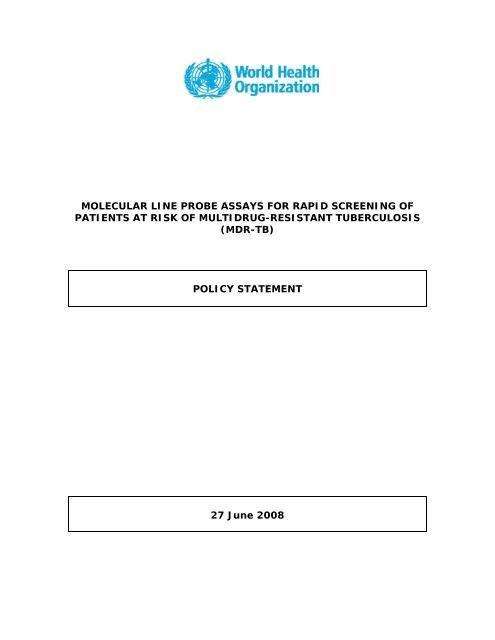
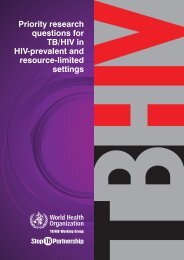
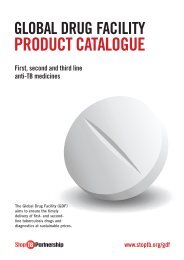
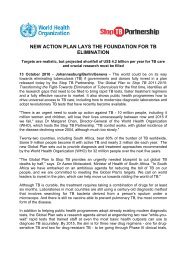
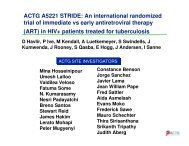
![Global Drug Facility Annual Report 2011 [.pdf] - Stop TB Partnership](https://img.yumpu.com/26788745/1/184x260/global-drug-facility-annual-report-2011-pdf-stop-tb-partnership.jpg?quality=85)

![Concept note on national stop TB partnership [.pdf]](https://img.yumpu.com/26788741/1/184x260/concept-note-on-national-stop-tb-partnership-pdf.jpg?quality=85)
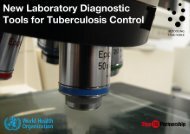

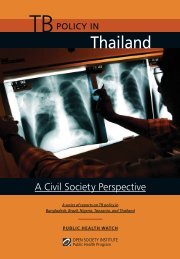
![2005 and Challenges for 2006 - 2015 [.pdf] - Stop TB Partnership](https://img.yumpu.com/26788674/1/190x245/2005-and-challenges-for-2006-2015-pdf-stop-tb-partnership.jpg?quality=85)
![Brochure (French) [.pdf] - Stop TB Partnership](https://img.yumpu.com/17234792/1/190x91/brochure-french-pdf-stop-tb-partnership.jpg?quality=85)

